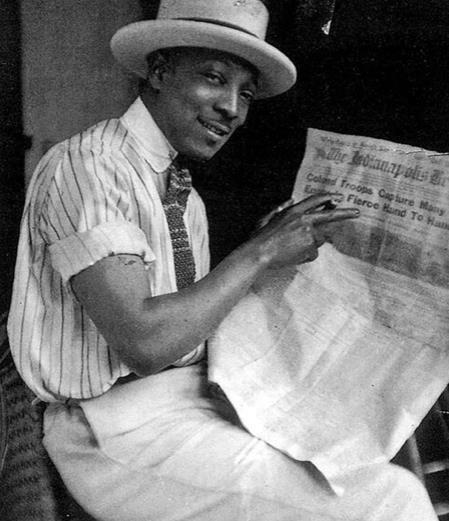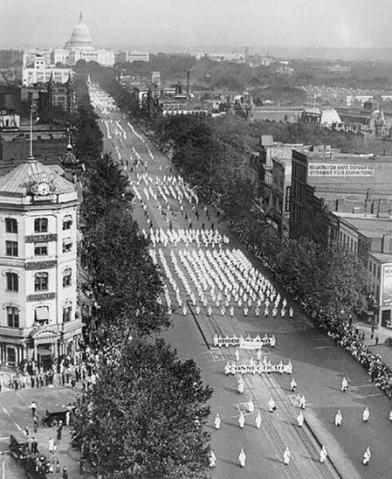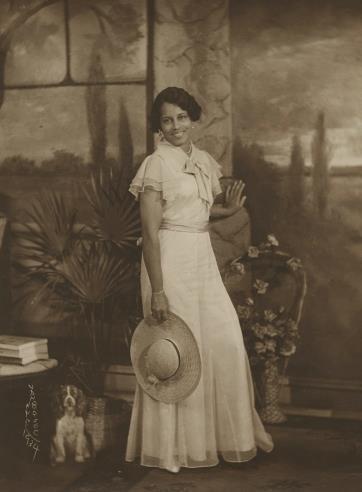1886
1983
Lenox, Massachusetts, USA
American
James was born in 1886 in Lenox Massachusetts, a rural town known as a summer resort for wealthy families. The Van Der Zees were one of the few Black families in Lenox and most of James’ neighbors and schoolmates were white. He grew up surrounded by art, music, and extended family,who all lived nearby on Hubbard Street. Together they raised livestock and gardened.. James’ aunts ran laundry and bakery businesses catering for the wealthy white tourists who visited in the summer. His father was sexton at the Episcopal Church, which had been built in 1888.
James left school at the age of 14 to work as a waiter at the Aspinwall Hotel, and was already experimenting with photography. Having won his first camera, he soon bought a larger one with his earnings. He set up an improvised darkroom in his parents’ house and took hundreds of photos of his family and hometown, creating one of the earliest photographic records of rural New England life, while teaching himself to shoot, develop, and retouch pictures. He evolved a Pictorialist style, wanting his images to be even more beautiful than real life.
With few opportunities to advance in the area, James and his brother moved to Harlem in 1906, when it was a middle class white neighborhood. James worked as a waiter and elevator operator to support himself as he pursued his ambition to become a professional musician. He formed the five piece Harlem Orchestra and later played with other ensembles. More family members followed James to Harlem, including his sister Jennie who was better known by her married name Madame E. Toussaint Welcome. Betty and her husband founded the Toussaint Conservatory of Art and Music in Harlem. They ran an ad in the inaugural issue of The Crisis magazine that declared her The Foremost Female Artist of the Race.Toussaint would become one of the first and only Black female filmmakers of the silent film era.
During the 1920s, Harlem was the epicenter of an explosion of Black artistic and cultural creativity, and James was there to capture it on film. In addition to portraits, he photographed weddings, funerals, baptisms, graduations, parades, clubs, sports teams, holiday photos, and scenes of daily life. This period is now called the Harlem
Renaissance but at the time was known as the New Negro Movement. The New Negro was proud, independent, and upwardly mobile. Finally able to express themselves outside the narrow confines imposed on them by white society, Black innovators made major contributions to American art, literature, music, dance, fashion, and politics. Harlemites like author Zora Neale Hurston, poet Langston Hughes, and jazz icon Duke Ellington defined the age. James photographed many Harlem celebrities including boxer Joe Louis, cabaret performer Florence Mills, religious leader Father Divine, pianist Hazel Scott and her husband Rev Adam Clayton Powell Sr.
During this time, thousands of Black New Yorkers trusted James to capture what might be the only photograph ever taken of them. They came to his studio dressed in their best clothes and James took time to ask his clients about themselves and where they were from, to get a sense of their personalities. He chose from his collection of elaborately painted backgrounds and props accordingly. His portraits were carefully staged and later retouched, to present the subjects looking their best. In his darkroom he painstakingly erased wrinkles, crooked teeth, and bald spots. James experimented with techniques such as photo montage, combining multiple images into one picture, for example superimposing a young girl’s portrait over her own funeral scene.
In 1924 Black separatist leader Marcus Garvey hired James as the official photographer of the Universal Negro Improvement Association (UNIA). The UNIA was often at odds with other prominent Black leaders and organizations like W E B du Bois and the National Association for the Advancement of Colored People (NAACP). A Jamaican immigrant, Garvey connected the experiences of people of African descent around the world who had been forcibly dispersed by colonialism. He advocated for an African Empire (with himself as provisional president) and courted controversy by working with members of the Ku Klux Klan towards their shared goal of racial segregation. Using patriotism in defense of white supremacy, the KKK was at its height during the 1920s with millions of members nationwide. Espousing hatred of Black people, immigrants, Catholics, Jews, bootleggers, intellectuals, and anyone who disagreed with their fundamentalist ideology, they infiltrated state and local governments and police forces to create what they called the Invisible Empire to enforce white supremacy and racial segregation across the country.
During the Great Depression of the 1930s, James and his wife had to move their studio but were able to stay in business. They survived the tough economic times and the uncertainty of World War II but as personal cameras became more affordable and available to the public, there was less demand for James’ professional services. To survive economically he resorted to doing mail-in restoration work and taking pictures for ID cards and insurance companies. By the 1960s, as the Civil Rights movement brought conversations about racial justice to the forefront of American life, the Van Der Zees were being threatened with eviction.
Lady with Wide – Brimmed Straw Hat, 1934
In 1968 photographer Reginald McGhee found James’ Harlem studio. When James showed him his collection of over 100,000 photographs, negatives, and plates spanning decades, McGhee immediately recognized their importance. He arranged to have some of James’ photographs enlarged and featured in an exhibition at the Metropolitan Museum of Art called Harlem On My Mind.” The exhibition was controversial because it did not include any paintings or sculptures by Black artists. Yet James’ sophisticated photos and his dignified subjects challenged the preconceived stereotypes many white Americans held about Black people and Black history. Suddenly, James was getting national recognition. Just weeks after the exhibition opened, the Van Der Zees were evicted from their home of nearly three decades. James was forced to give his collection to McGhee, who later transferred it to the Studio Museum in Harlem.
Despite continuing financial troubles, the art world and the general public became even more fascinated by James and the decades of Harlem life he recorded. His photographs were featured in a large spread in Ebony magazine in October 1970. In 1978, some of his funeral portraits were assembled into a book The Harlem Book of the Dead. President Jimmy Carter honoured him with a Living Legacy Award. A new generation of Black celebrities including Muhammad Ali, Lou Rawls, and Jean Michel Basquiat considered themselves honoured to have James take their portraits.
In 1907, James married his first wife, Kate Brown, and they moved to her home state of Virginia for a year. While there, he worked as a waiter at another resort hotel for wealthy white people. He also photographed the students and faculty of the Whittier School, a preparatory school for Hampton Institute. After his daughter Rachel was born, the family moved back to Harlem. James and his wife separated soon after their infant son Emile died in 1911. Rachel died when she was only 15.
After working as a darkroom assistant and occasional portrait photographer in a New Jersey department store, James opened his own portrait studio in Harlem in 1916 with Gaynella Greenlee Katz, his second wife and business manager. The studio in 135th Street quickly became a destination for Harlem’s growing Black middle class. By the mid 1920s, there were nearly 200,000 Black people living in the neighborhood. They were among the 6 million Black Americans who migrated from the Jim Crow South to cities in the north and west between 1915-1970. Oppressed and segregated in the south, they sought opportunity elsewhere. This major demographic shift is known as The Great Migration.
KKK Parade in Washington, DC, 1926.
In 1983, just hours after receiving an honorary degree from Howard University, James died of a heart attack at the age of 96.
https://www.biography.com/artist/james-van-der-zee
https://explore.berkshiremuseum.org/digital-archive/james-van-der-zee-photographingthe-harlem-renaissance
https://www.howardgreenberg.com/artists/james-van-der-zee





